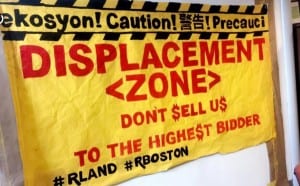Health Care Access (’16)

A banner ACE is using to help fight unfair evictions throughout Roxbury
The Problem: Gentrification is an ongoing issue within growing cities. Though a developed city makes a city more desirable, it also makes a city more expensive. With an increased demand for housing, housing prices skyrocket, making it more costly to live in a gentrified area. This makes it difficult for people of lower income to continue to live in their once affordable neighborhood, causing them to be forced out of their community. When lower income residents are displaced further away from where they once lived, they are forced to travel further distances in order to access work, school and health care. When traveling further distances, especially in inner cities like Boston, lower income residents rely on public transportation to get to these places. In a recent study conducted by Alternatives for Community and Environment, 52% of the respondents relied on the public transit system in order to get to their health center. Of those surveyed, 48% reported missing or arriving late to health related appointments because of transportation related issues. (Alternatives for Community and Environment, 2015). The further distance from lower income patients community health centers, as well as the use of public transportation to get to these health centers, impacts these patients’ access in a negative way.
Goal/Objectives: The goal of this project was to understand the impacts and challenges displacement and public transportation has on access to health care. In order to achieve our goal, we completed the following objectives:
- Identified the health care choices of patients before and after displacement
- Identified the barriers of health care access by displaced patients
- Determined how displacement and transportation affect how often patients visit their health centers
Findings:
Finding 1: After facing displacement, people preferred the health center in the neighborhood where they previously lived
Finding 2: People who use public transportation budgeted more time to get to their health care appointments than those who do not take public transportation.
Finding 3: Efforts to budget extra time into commuting via public transportation appeared to help people avoid missing or being late to health care appointments.
Finding 4: Unpredictable public transportation schedules caused people to be late or missed appointments.


